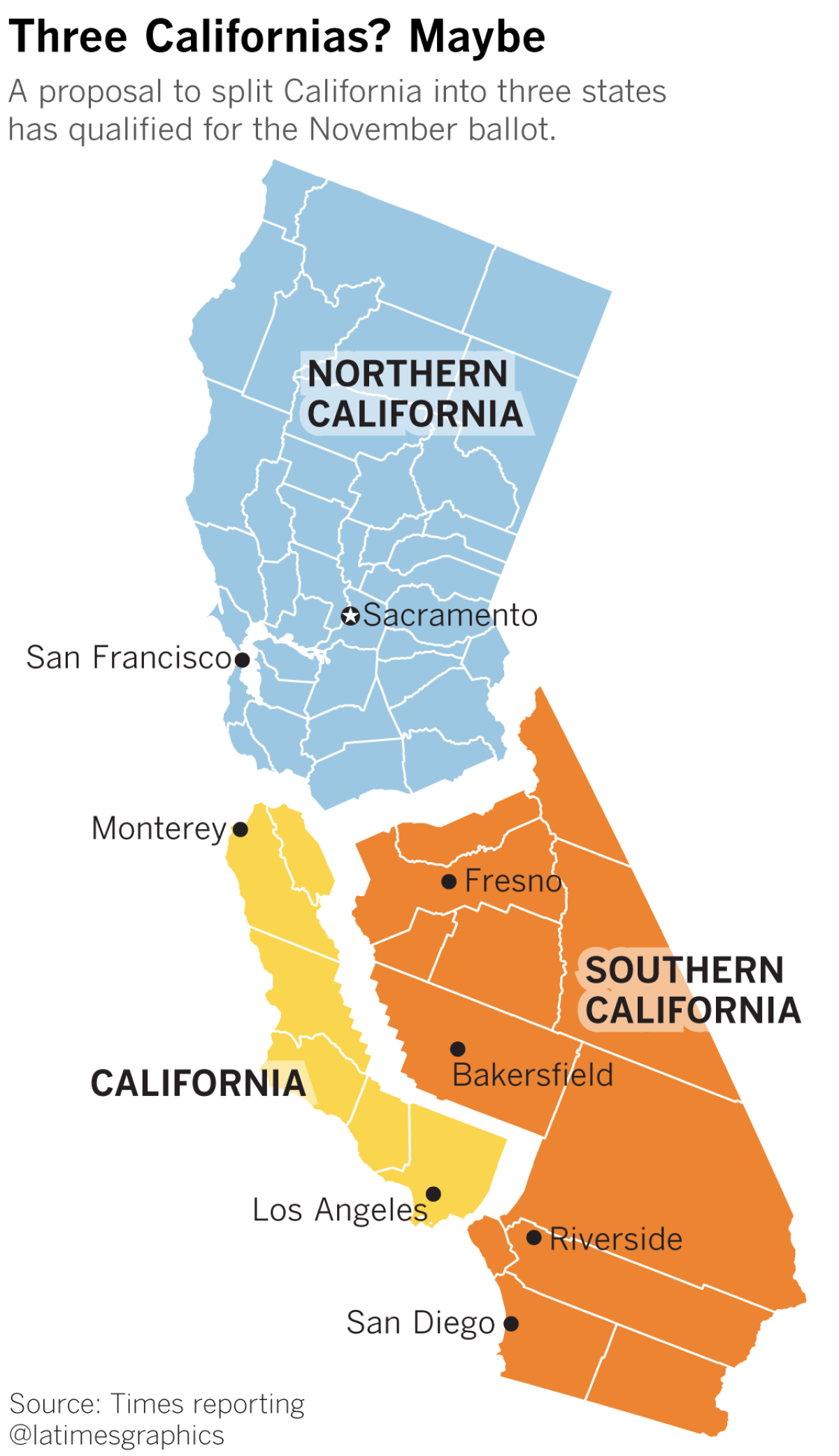Column: Venture investor Tim Draper is back with a pointless plan to split California three ways
The late Robin Williams used to have a great line about how “cocaine is God’s way of telling you you’re making too much money.” But it’s a new day and a different world now. Here in California, it may be more accurate to say that God’s way of saying you have too much money is to have you spend millions of dollars on a chuckleheaded and self-interested ballot initiative.
Case in point: Tim Draper.
Draper is the Silicon Valley financier whose ballot initiative to break up California into three states was certified this month for the November ballot. That achievement resulted from his submitting more than 365,880 valid petition signatures to the state attorney general’s office.
Sacramento’s a monolith.... We have the ability to become closer to our government.
— Three-California advocate Tim Draper in 2014
Onlookers might be tempted to think this signifies a groundswell of sentiment in favor of the measure, but they’d be wrong. It signifies Draper’s willingness to spend some $550,000 on professional signature-gathering.
Draper has contributed an additional $1.22 million of his money to what is now an official initiative campaign committee. The committee goes by the name of Citizens for Cal 3, although so far Draper is the only citizen putting his money where his mouth is.
Given the lack of evident clamor statewide for breaking up the state and the manifest fiscal imbalance that would result, Draper’s initiative looks more like an investment by a Silicon Valley fat cat to keep more of his money in the long run while telling the rest of California to go to hell.
The three-state plan is widely thought to have no chance of passage in November; political experts have so far treated the initiative as a silly stunt, with the attitude that there’s no downside to letting Draper have his fun.
But that’s not so. This is a dangerous and dishonest proposal, with consequences that shouldn’t be dismissed out of hand. As long as it’s on the ballot, anything can happen — unexpected election outcomes occur all the time. So it’s proper to examine the measure’s ostensible rationale and its implications seriously.
“Everyone assumes this is such a stupid proposal that it’s not going to go anywhere,” says former Assembly Speaker Fabian Nuñez, who is launching an opposition drive but is just beginning to raise money for it. “This is not a classroom exercise; it’s the real deal. All one has to do to run an initiative campaign is play to people’s fears or run against politicians.” The notion of partitioning the state is polling very poorly at the moment, but Draper, Nuñez observes, “has deep pockets. This is a threat.”
Some people have the charitable view that Draper is using the three-state idea to jump-start a public discussion of how best to govern California. We sought Draper’s personal input about that, but the Cal 3 campaign staff demurred, citing his “overpacked schedule.” Nor did he respond to calls left at his Menlo Park office.

Draper did, however, talk with us in 2014 about his previous effort in this sphere. That initiative to split California into six states didn’t make it onto the ballot. At the time, he explained that “Sacramento’s a monolith.… By creating six states, we have the ability to become closer to our government.”
A similar pitch is made by Cal 3. The initiative would create three states — Northern California, running from Santa Cruz north and including the Bay Area; Southern California, running roughly from Fresno through the Inland Empire and down to San Diego; and California, encompassing everything along the coast from Monterey to Los Angeles County.
According to its website, the initiative will “bring critical decision-making closer to home” in education, give “regional governments greater control over critical infrastructure spending” on roads and highways, “promote greater citizen oversight of and control over how taxes are being spent,” and “emphasize local identity,” whatever that means.
These ideas have a certain allure if you think California’s problem is purely bureaucracy — or to use the commonly heard term, that the state is “ungovernable.” But where’s the evidence for that? California’s economic expansion and job growth have been among the national leaders since the last recession. As we reported a few weeks ago, the state is a magnet for the wealthiest and best-educated working Americans.
Business lobbies have saddled California with the reputation of an anti-business state, but it’s still the largest consumer market in the nation. It’s true that taxes are high and labor and environmental regulations strict, and in some respects perhaps higher and stricter than they need to be. But there are no indications that California workers and families are demanding skimpier public services, dirtier air and water, or fewer workplace protections and lower wages.
Draper has waved away questions about the cost and complexity of partitioning the state, but that won’t do. Even if the initiative passed and was endorsed by the Legislature, the split would require congressional approval and a presidential signature. The difficulties of dividing the assets and duties held by present-day California in three would be massive.
Tripartite compacts would need to be reached to substitute for statewide jurisdictions over roads, water infrastructure, retirement funds and the higher education system, just for a start. Fragmented oversight of systems now managed regionally would create more bureaucracy, not less.
According to one independent analysis, if the nine University of California undergraduate campuses were ceded to their new states, more than half the undergraduates at eight would be reclassified as nonresidents, with UC San Diego topping out at 67.8%. The sole exception would be Davis, at 29%. Try to imagine the three-way negotiations over that.
But what’s most insidious about Draper’s proposal is the disproportionate distribution of wealth among the three new states. This isn’t merely about “Northern California” ending up as the second-richest state in the union based on per capita income and “Southern California” falling to 30th, as the Legislative Analyst’s Office calculated. It’s about how the size and diversity of California function to create a fairer and more prosperous life for all. Goods, services and business opportunities flow without restriction among all parts of California, in part because this is a big, diverse state.
What Draper is really after is the destruction of this system for the sole benefit of Northern California — indeed, the swath of Northern California known as the Bay Area.
As the LAO observes, the counties of Draper’s Northern California pay the highest per capita income tax of the three new states — $2,206, compared to $1,411 in his California and $1,059 in his Southern California. That’s because Northern’s income is concentrated among the wealthy, who pay the most in our progressive income tax system. The property tax base is also highest in Northern California — the only one of the three states with a higher per capita assessed value than the statewide per capita value today.
Only in sales taxes is the ratio reversed: Southern residents would account for 36% of the total sales tax base, California 28% and Northern only 27%. That’s because the sales tax is regressive — lower-income residents pay more of it than the middle class or rich.
As for state spending, thanks to the bizarre post-Proposition 13 system by which K-12 education is funded — mostly by the state, less from local property taxes — Northern California would get less state assistance for its K-12 system and spend more local resources on it.
Unique among the three future states, Northern California would have a smaller Medi-Cal caseload than its share of present-day California’s population (28.8% of Medi-Cal cases and 33.5% of the population). Similar ratios would prevail in spending on CalWORKS, the state’s welfare program.
This all means that the counties comprised by the new Northern California are net exporters of tax revenue to the rest of the state, largely for the benefit of lower-income residents elsewhere. It’s not especially surprising that a Silicon Valley venture investor would find something irksome in this situation.
But it’s worth noting that the imbalance in income against outflow exists intrastate too — Northern California would encompass not only the richest counties, but some of the poorest. (To quote the New Testament, “The poor you will always have with you.”) The burden of providing for the less fortunate would fall even heavier on the wealthy in Southern California and California.
No one claims California is easy to govern, much less perfect. But solutions to some of its most pressing problems, including the dysfunctional taxation structure, have been under discussion for years. Many of the proposals focus on revising Proposition 13, a ballot initiative that looked good on the surface and has created a mess ever since.
No one with any brains has suggested that the answer is to make governance even more complicated. If Tim Draper is serious about making a contribution to these questions, he should withdraw his three-state plan and put some thought into real solutions, starting with what to do about Proposition 13. But maybe he doesn’t really care.
Keep up to date with Michael Hiltzik. Follow @hiltzikm on Twitter, see his Facebook page, or email michael.hiltzik@latimes.com.
Return to Michael Hiltzik’s blog.







